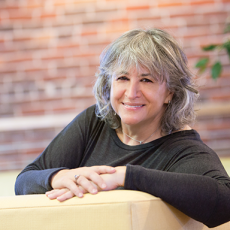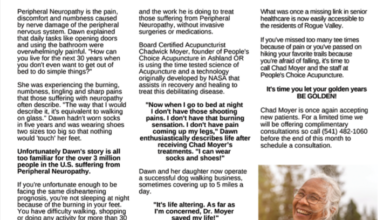Gail Frahm – EMyth Business Coaching
 Almost thirty-seven years ago, EMyth pioneered the small business coaching industry that now generates $9 billion a year in revenues. Over that time, EMyth has helped small business owners around the world learn how to build a business that truly works through coaching and training. Their clients have come from every conceivable industry. EMyth currently employs 20 people in Ashland and supports over 70 independent, EMyth Certified Business Coaches on every continent except Antarctica.
Almost thirty-seven years ago, EMyth pioneered the small business coaching industry that now generates $9 billion a year in revenues. Over that time, EMyth has helped small business owners around the world learn how to build a business that truly works through coaching and training. Their clients have come from every conceivable industry. EMyth currently employs 20 people in Ashland and supports over 70 independent, EMyth Certified Business Coaches on every continent except Antarctica.
So, what happens when a company in the business of helping business owners transports their personal values through their business discovers that it hasn’t followed its own advice? In 2011, business owner Gail Frahm, a long-term resident of Ashland, took on these issues in a rather bold way. She decided to move the company from northern California, where it was headquartered since 1977, to Ashland. She not only brought the company closer to home, but closer to the management team and a group of advisors she entrusted to re-imagine her company.
What she didn’t anticipate when she decided to move the company was that her new CEO would ask her to step away from the company for a year, to see what a future could look like that honored the company’s past but wasn’t constrained by it. Gail recognized the opportunity for herself and for EMyth, and did just that. In October 2011, EMyth opened its doors in downtown Ashland and embarked on a journey to reinvent the brand, the company’s values, its culture, its systems, and its services.
In December 2012, Gail returned to the Board, and a year later, invigorated by what the company had become, Gail stepped back into the role of EMyth’s CEO, a position she hadn’t occupied since 1999.
Now in its third year in Ashland, EMyth is settling into its home here while expanding its reach into small business communities throughout the world. I had the opportunity to speak with Gail Frahm about EMyth and the company of the past, present and future.
Gail thanks for speaking with me today. I’d also like to thank you for moving EMyth to Ashland. How did you decide to do that?
We’re glad to be here. It’s a joy and a bit of an irony for me that the company is right downtown, for the first time in its history,
in the middle of the kind of Main Street small business community EMyth was created to serve. I moved here ten years
ago from Petaluma, California with my children who were 12 and 16 at the time. I was recently divorced and Ashland was the start of the next chapter of my life. At first, traveling back to the Bay Area for meetings was a welcome feature of my life. Over time, I began to feel more and more distant from the company. I wasn’t ready to sell EMyth, so I decided to move it to Ashland and reinvent it.
To begin, can you please give our readers a little bit of background on the company.
EMyth was founded in 1977 in San Mateo, California by Michael Gerber, my ex-husband and the author of the best-selling book, The E-Myth Revisited: Why Small Businesses Don’t Work and What to Do About it (HarperCollins 1995). The company was created to provide a low-cost alternative to business consulting that was out of reach for most small business owners at a time when the coaching industry didn’t exist. It was built on the premise that by taking high-priced expertise and putting it into a system that could be delivered by relative novices, small business owners could take advantage of the best business solutions out there at a fraction of the cost.
In 1985, Michael was offered a contract to write a book on small business that became the original The EMyth, which you may or may not know, stands for ‘the entrepreneurial myth’. The idea is that it’s a myth that small businesses are started by entrepreneurs, risking capital for a return on investment. Most small businesses are started by technicians, people who’ve developed a technical craft working for someone else: plumbers become plumbing contractors; hair stylists open hair salons, and so on. And, that’s why they fail at such an alarming rate. Technicians understand technical work. They often don’t under-stand how to build a business that does that technical work. So, they create a job, a business that’s completely dependent on them, which is fine until they don’t want to do it anymore. The company was created to support small business owners in making the transition from ‘technician’ to entrepreneur by showing them how to build a business that operates profitably whether they’re there or not. So they finally have the choice, something most technicians turned business owner never get.
Gail, I know you’ve played a pivotal role in the company. Can you talk about your history with the company?
I joined EMyth in 1982 when I was 29. I had just moved to northern California from New York, and EMyth was my first job there. Though my passion and background were in personal development, I started at EMyth as a salesperson and within months I became the company’s sales manager. It gave me an unexpected opportunity to meet people where they lived, inside the real pain and frustration of trying to grow a small business, and to help them find their desire to transform themselves in the process of transforming their business. Along the way, Michael and I fell in love. We got married in 1985 and spent 20 years in partnership building EMyth together. While Michael was speaking throughout the world on the EMyth Perspective and writing several books in the EMyth series, I was taking on more responsibility for growing the company, developing and integrating EMyth’s business approach to personal growth, managing the company’s day-to-day operations, eventually becoming the Chief Executive Officer in 1995. I was also involved in Michael’s publishing business, as both the editor of his books and his publishing agent even after we separated in 2002. I was quite driven during this time in my life, raising two children, running a growing company, navigating a partner-ship in business and a marriage that just happened to be with the same person, and finding time for myself. It was never easy, mostly because I didn’t know who I was.
In the late ‘90’s, I became increasingly dissatisfied with my life, my marriage and my work at EMyth. I could no longer hide how miserable I was, mostly from myself. I wasn’t sure why or exactly what I was looking for. I only knew two things: that I didn’t know what it meant to be a leader and that I had to stop pretending I did and that I didn’t know “the sound of my real voice” and wanted to find it. In 1999, after some painful introspection, I retired from the operations of EMyth, remaining only on the Board, to discover what else life had in store for me.
Where did your life take you over the next several years and what happened to EMyth during that time?
When I left EMyth, it took me some time to detox from the intensity I had created and to learn how to slow down. I had two young children who were very happy to have their mother back full time. I started exploring emotional and spiritual growth paradigms that I felt could help me answer my questions about myself. Nothing I did was able to save my marriage, and Michael and I separated in 2002. Initially, we remained good friends and maintained our business partnership at EMyth. We agreed that the company needed professional management to take it to the next level of growth, a practice that started in 2004 and continued to 2013 when I became the CEO again for the first time in 14 years.
Despite the brand recognition that EMyth has achieved over the years, at some point it became apparent that something was missing. Gail, can you talk about this and what you decided to do about it?
Until recently, most of the success the company had achieved was the result of the impact of The E-Myth Revisited book. Its popularity has been staggering: over 7 million copies sold, on the New York Times and Wall Street Journal best seller lists, one of the top 10 best selling business books of all time, translated into 29 languages. The E-Myth Revisited has changed the global conversation about how small business owners think about growing their business and it’s changed lives. People have been coming to EMyth and still come for help to make the changes the book talks about.
In 2010, I started to become aware of some of the ways that the emphasis on systems, something EMyth has become known for, was actually limiting the growth of the company. I started working with the senior staff in an effort to facilitate change but, for whatever reason, things weren’t moving the way I had hoped. In the spring of 2011, I was driving home from meetings at EMyth’s offices in Santa Rosa, California when I realized I would move the company to Ashland.
It sounds like a big deal to stop mid-stream with a company in motion and make fundamental changes. What was most challenging for you in making this move?
It was definitely a big deal. Everything was unknown though it just felt right. The biggest questions were: Could I put together a management team that was excited about and committed to transforming the company in a way that didn’t ignore systems but made them values-driven? Could I find office space that had the feel we wanted? And, could we minimize the inevitable upheaval created by the move on our employees, most of whom lived in and around Santa Rosa?
I only had an opportunity to directly answer the first two questions. Soon after I hired a new team of senior managers and found the company’s downtown office space, EMyth’s new CEO, Jonathan Raymond, asked me to step away from the company completely for a year while he and the management team set out to re-imagine the company. I’ve asked Jonathan, currently EMyth’s Chief Brand Officer, to join us today to talk about his experience.
Jonathan thanks for joining us. Can you say more about what it meant to re-imagine the company, and why it was important that Gail step away?
Sure. The thing that struck me was just how much unrealized potential there was in the company and, really, the brand. There was a clear gap between the success and popularity of the book and the core ‘message’ about working on your business, not in it, and the company that was operating in relative obscurity. And, like a lot of small businesses that hit plateaus, most of the time that limit is in some way or another self-imposed. No one under-stands that better than Gail.
For us, it meant going back and redoing some of the foundational work we do with our clients. Things like clarifying our company values, writing a three year vision, figuring out what our brand really stood for in a way our employees could rally around. And, it was in that process, with all the bumps and bruises that come with it, that we found a way to talk about what we do that was more human, more in line with how we all saw the world and felt we could really help people. The most essential shift was from a “systems first, people second” orientation to a “people first, systems second” one.
I’ll explain. EMyth gained popularity with small business owners because it nailed a universal truth, that people go into business because they’ve developed a craft, not because they know how to build a business. So, they find themselves facing endless issues they’re not prepared for. No matter the industry, the problems are the same: ‘There’s not enough time in the day.’, ‘Where’s the cash going?’, ‘How do I get my people on board?’, ‘Who are my best customers?’, ‘How do I find more of them?’. EMyth has always had an impressive library of small business solutions, systems and tools, which we’ve refined over 35 years, so that business owners can move out of that overwhelm step by step.
But, there are questions that need to be asked before you install systems – about what they’re designed to achieve and whether that’s the right result. Those questions speak to the owner’s values and how they’re transported through the business. So the business really has meaning for the owner and the split between life and business disappears. That’s change at the level of the owner. Everyone that the business impacts is actually dying to feel the owner’s passion for growing the business. When owners figure out their values and start from that place, they want to work relentlessly to improve the business processes until they’re just right. And there’s no quick fix or ‘one size fits all’ system for that – but there are a ton of systems that come from that journey.
Thanks Jonathan. So, what’s it been like for you, Gail, to step back into the company you originally built that changed so much in your absence?
This may sound counter intuitive, but it felt like coming home. It didn’t take me very long to feel the transformation in the culture – the passion, creativity and degree of self-responsibility among our employees, the level of support for our coach network in building their practices across the globe, the way that technology was being used to facilitate communication between our staff and coaches, and between coaches and clients, the on-going impact on our clients of their learning how to bring more of themselves into their business. Jonathan and his team did an amazing job of allowing the potential in the company to be fulfilled. And, during all the years I was away from the company, I found enough of my real voice and learned enough about real leadership that I can have the experience, on a daily basis, I’m where I belong. Of course there’s still work to be done: we plan to more than double the number of coaches and clients in the next three years as well as exponentially expand the number of subscribers to our self-paced online platform.
I understand that EMyth offers local Ashland businesses a way to access some of EMyth’s resources at no cost. Gail, can you tell me about that?
Yes, one of the things we’ve done in recent years is give business owners a view into our curriculum, so they can see the material directly and how it applies to them. It’s part of the reason we launched our online platform in 2012, as a place to ‘start the conversation’ on their terms. And, for anyone interested in working with one of our certified coaches directly, we’re a click or a call away – or a stroll down the street to our office at 139 E. Main. We live in this community which is already a success story in many ways, and yet businesses go out of business here all too often, and so many owners struggle with the same things business owners do all over the world: competition on the web, high employee turnover, low prospective customer to sale conversions, inadequate average sales, challenges with planning and managing their cash. There are no quick fixes, but there is a process, a way to go step by step to really change things. We’re dedicated to helping small business owners create more meaning in their lives. We’d love to share our process with more businesses here in town and in the Valley.
Learn More:
EMyth
139 E. Main St. Ashland
(800) 221-0266




